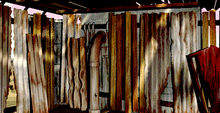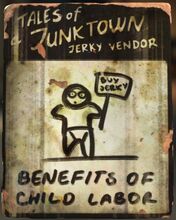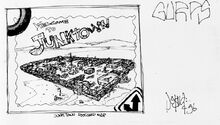Junktown is a major settlement in southern California appearing as a location in Fallout and mentioned in subsequent installments of the Fallout series. It can be found one square east and nine squares south of Vault 13 and four squares north of the Hub.
Known for catering to weary travelers and roughhousing gangsters alike, the town was one of the first substantial trading hubs to crop up post-War on the West Coast. By the late 22nd century, after a local power struggle was settled within its walls, Junktown was integrated into the nascent New California Republic and became a founding member of its provisional state of Shady, along with sister settlement Shady Sands.
Background
Trading junk at Junktown
Junktown was founded shortly after the War by Killian Darkwater's grandfather, a former soldier of the US military,[2] nestled amongst the southern tip of the Sierra Nevada mountains.[3] Instead of building on the ruins of an old town, the ancestral Darkwater thought it would be better to begin from the ground up. As its name suggests, Junktown's defining structures were created out of random pieces of junk, mostly from wrecked cars left in the wake of the bombs. In the post-nuclear wasteland, the town mostly lives off of trading and has a reputation for open hospitality so long as one is hospitable in return.[4][5]
By 2161, the mayor of Junktown was Killian Darkwater, grandson of the town's founder, who also ran the Darkwaters General Store. Despite his lineage claim, Killian faced competition for control of Junktown from another player, Gizmo, big-time crook and casino owner. Though Gizmo's gambling hall brought a lot of tourists and money into the town, problems also came with it due to the man's scarcity of scruples and propensity for back-alley deals and death-dealings. Other important places in Junktown at that time included the Crash-House Inn, home to the Skulz street gang, and the Skum Pitt, a bar owned by Neal. Doc Morbid was the town's doctor. Tycho of the Desert Rangers also resided in Junktown for a while at that time.
Owing to its welcoming reputation, drawing weapons in Junktown is not permitted except in self-defense and the gates to the town are closed at night. Lars headed the guards in Junktown, working under the mayor Killian Darkwater and assigned Kalnor to guard the gates at night, and Andrew to overseer the town jail. The guards were aware of the illegal activities of Gizmo and the Skulz, but they didn't want to act without proper evidence. Around the early 2160s, Gizmo hired an assassin to take out Killian and assume full control over the town.
To date it is unclear as to what the outcome of Killian and Gizmo's power struggle was post-2161, as the Vault Dweller's memoirs are ambiguous concerning events in Junktown, save for that he remembered his time there as "tainted" and how he will "feel no remorse for [his] actions in that place."[6]
Rising with the Republic
Over two decades after the fall of the Master and the Unity, in 2186, Junktown joined with their northern neighbor of Shady Sands to become part of the developing New California Republic, with both forming the core of the first provisional state of Shady; Junktown's inclusion came as a result of it being one of the first and most trustworthy of Shady Sands' trading partners during its early formative years. The alliance between Junktown and the NCR did cause some alarm from caravan leaders in the Hub at first, but once they saw the fruits of NCR's success, the Hub too eventually became part of the growing nation as well.[Non-game 1]
By 2281, Junktown is said to have prospered into a farming community, with some known to own acres of land in the hundreds.[7][8] A series of books/magazines about trading and barter were also written by an unnamed jerky vendor from Junktown.[Non-game 2] They proved popular enough that issues could be found distributed to places on the East Coast like the Capital Wasteland and the Commonwealth, even reaching the opposite corner of the continent on Mount Desert Island in Maine.
Location
Junktown can be found one square east and nine squares south of Vault 13. It is four squares north of the Hub.
Layout
Junktown is divided into three districts.
| Gizmo's Casino |
|---|
| ↑ |
| Crash House |
| ↑ |
| Junktown entrance |
| ↑ |
Entrance
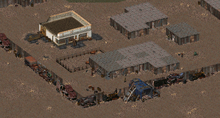
The only entrance to Junktown. People need to holster their weapons or they will not be accepted into the town. This part of this town consists of a hospital where Doc Morbid heals his patients, (at a high cost) and a jail where people who do not abide by the law are held.
Crash House
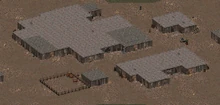
The Crash House is a hotel where travelers rest. It also contains a back door where the Skulz make plans. Near it is Killian's store where people can buy weapons, ammo, medicine, etc.
Gizmo's Casino
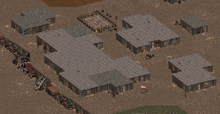
Gizmo's Casino is the most decorated building in Junktown. Some, however, believe the dealers are cheats and the games are rigged. Near the casino there is the Skum Pitt, a bar run by Neal and the boxing ring, with Saul as the champion.
Inhabitants
Quotes
- "It has potential, although I don't know if building out of the refuse of the past is the best way to construct the future." - Tycho
- "But this is not a city of open hospitality. If you desire that, go to Junktown." - Aradesh of Shady Sands
- "My father used to tell me stories about the War. His father was a soldier before starting Junktown." - Killian Darkwater
- "You'd better put that away. Junktown is a friendly place, friend, and we want to keep it that way." - Kalnor, a Junktown guard
- "Junktown is a little south and a ways west. It's smaller, but still a good place to drop in for a drink. It's overseen by a fellow by the name of Killian Darkwater, the local shopkeeper, sheriff, and mayor." - Ian
- "Junktown's pretty tame. I prefer the more dangerous routes." - Keri of Crimson Caravan
- "It was here that I learned the most important rule of all: doing a good thing sometimes means being a very bad person. My memories of Junktown are tainted, and I feel no remorse for my actions in that place." - Fallout 2 manual
Notes
- The background music when visiting Junktown in Fallout is Industrial Junk, which later appears in the series being used for Gecko in Fallout 2 and Vault 11 in Fallout: New Vegas.
- If the Vault Dweller does not holster their weapons inside, the Junktown guards will be hostile.
Appearances
Junktown appears only in Fallout. The location is mentioned in Fallout 3, Fallout: New Vegas, and Fallout 4 by association with the Tales of a Junktown Jerky Vendor magazine series.
Behind the scenes
- Junktown does not correlate to the name or location of any real-world city.[Non-game 3] Based on the in-game map, its location appears to be set west of the present-day city of Ridgecrest, California.
- The initial design for Junktown called for the ending cards of the city to be reversed. Specifically, if the Vault Dweller sided with Killian Darkwater, then Killian's firm "frontier justice" would discourage traders and merchants from starting businesses in the area, leaving the city a small shantytown. If the Dweller sided with Gizmo, then the resulting prosperity brought in by Gizmo's casino led to the city becoming a new boomtown. Ultimately, it was decided that this mixed message was unsatisfying because it meant that the expected results (a "good" ending for supporting Killian and the law, versus an "evil" ending for supporting Gizmo and his criminal enterprises) did not match the player character's actions. The ending was subsequently changed so that supporting Killian led the town to prosper with law and order while supporting Gizmo turned the town into a seedy den of iniquity.[Non-game 4]
- Fallout originally had a more dynamic wasteland, with the super mutants expanding and invading settlements across the wasteland as time passed by. The longer the player took to complete the game, the more settlements would be invaded, with all characters removed, with only super mutant invaders present. A remnant of this mechanic can be seen with Necropolis, where entering after 110 days pass triggers the invasion: All ghouls are killed off by script, with super mutant invaders added to surface maps, along with a ghoul refugee who recounts the invasion. The time limits are still included in Vault13.gam and are as follows:
- Followers of the Apocalypse would be invaded 90 days after the start of the game (March 5, 2162).
- Necropolis falls after 110 days (March 25, 2162).
- The Hub falls after 140 days (April 24, 2162).
- Lost Hills is invaded after 170 days (May 24, 2162).
- Junktown is invaded after 200 days (June 23, 2162).
- Shady Sands falls after 230 days (July 23, 2162).
- Vault 13 finally falls and the game ends in a fail state after 260 days pass (August 22, 2162). This was modified to 500 days for release (corresponding to April 19, 2163).
- In the end, the idea of introducing a distinct, invaded variant of the major locations was scrapped in favor of focusing on finishing the game. However, the time limits were retained and entering any of the locations except for the Brotherhood does trigger the corresponding bad ending in the end slides (eg. entering The Hub after 140 days pass triggers the destruction ending; for Followers, all that suffices is entering the Blades' map).
- The time limit for the Vault 13 invasion was lengthened from 260 days to 500 for release, to reduce the time pressure, before being completely removed in subsequent patches. It was also affected by other factors: Purchasing healing from the Children of the Cathedral reduced the time limit by 1 day, ordering water deliveries from Martha Rastello reduced it by 90 days, while blowing up the Mariposa control computer to trigger the self-destruct sequence halved the invasion time limits for Vault 13, Shady Sands, and The Hub. The removal of the hard time limit only affected Vault 13, with the functionality retained for the other two locations.
Gallery
Soundtrack
See also
References
- ↑ Ton Barracus: "{197}{}{You annoying little piece of shit. You're worse than a Junktowner, you coward. Get the hell out.}"
(BARRACUS.MSG) - ↑ Killian Darkwater's dialogue: "{261}{Kill82}{Where've you been for the last 100 years? In a closet? My father used to tell me stories about the War. His father was a soldier before starting Junktown.}"
- ↑ As seen on the Fallout world map.
- ↑ Aradesh's dialogue: "{134}{Ara_10}{And keep them you may. But this is not a city of open hospitality. If you desire that, go to Junktown. You may enter, but know we have our eyes on you.}"
- ↑ Kalnor's dialogue: "{110}{}{You'd better put that away. Junktown is a friendly place, friend, and we want to keep it that way.}"
- ↑ Fallout 2 manual: "It was here that I learned the most important rule of all: doing a good thing sometimes means being a very bad person. My memories of Junktown are tainted, and I feel no remorse for my actions in that place."
- ↑ The Courier: "Who are you?"
Frank Weathers: "My name's Frank Weathers. I'm a farmer, got a few hundred acres near Junktown. Well, I was a farmer. I guess I'm not much of anything now."
(Frank Weathers' dialogue) - ↑ The Courier: "Why'd you come all the way out to New Vegas?"
Frank Weathers: "Why does anybody? I thought I'd strike it rich at the tables, make my fortune and never have to plow those damn fields again. I just wanted to provide for my family - and now they're gone. All gone. God forgive me...."
(Frank Weathers' dialogue)
Non-game
- ↑ Fallout Bible 5 Questions: 14. One thing - what's happened to Junktown? Was it just too little to be it's own state? Or maybe it has managed to survive as an independent enclave inside NCR, a hive of scum and villainy, so to speak. And what kind of folks would live in Glow? After all, that place must still, well, glow, at least somewhat. Ghouls?
"Junktown became part of NCR as part of the state of Shady, and it was one of the first provisional states, considering it was one of the first (and most trustworthy) of the Shady Sands trading partners during its early formation. Its alliance with Shady Sands did cause some alarm from the caravans in the Hub, but it didn't hurt the Hub communities any... and the Hub eventually became part of NCR as well."
"As for the Glow (or the state of Dayglow), most of the state is actually north and west of the glow, but they are still able to see the Glow from their borders. A number of ghouls are rumored to live there now, as part of the Great Migration from Necropolis - once the ghouls learned of West Tek, they were eager to see if they could scavenge technology from the abandoned center. Some ghouls formed partnerships with scavenging companies from New Adytum and the Hub and have built quite a profitable corporation from their salvage efforts. At least one super mutant, a refugee from the Cathedral, was also rumored to be working with the ghouls and humans in Dayglow." - ↑ Fallout: The Roleplaying Game Rulebook p.177: "One example of a post-War magazine, Tales of a Junktown Jerky Vendor is a collection of short, handmade books written by an unknown vendor of jerky from Junktown. Copies have spread across the wasteland and can be found from California (near Junktown itself) to the Commonwealth."
- ↑ Fallout Bible 6: 1) Are the Fallout locations made according to real places, or did you make them up? I mean specifically the Hub, Junktown, Gecko and Modoc.
"Some are based on real places (Necropolis = Bakersfield, Klamath = Klamath Falls, Redding = Redding), but the Hub, Junktown, and Gecko were all made-up locations."
"Modoc most likely took its name from the Modoc National Forest located near the location. "Modoc" was originally the name of an Indian tribe in the region, I believe. Arroyo is a fictional locale, according to Tim Cain." - ↑ Jess Heinig's interview on Fallout Bible 9
| ||||||||||||||||||||||
| ||||||||||||
